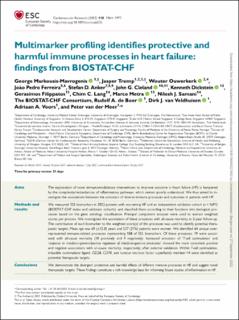| dc.contributor.author | Markousis-Mavrogenis, George | |
| dc.contributor.author | Tromp, Jasper | |
| dc.contributor.author | Ouwerkerk, Wouter | |
| dc.contributor.author | Ferreira, João Pedro | |
| dc.contributor.author | Anker, Stefan D | |
| dc.contributor.author | Cleland, John G | |
| dc.contributor.author | Dickstein, Kenneth | |
| dc.contributor.author | Filippatos, Gerasimos | |
| dc.contributor.author | Lang, Chim C | |
| dc.contributor.author | Metra, Marco | |
| dc.contributor.author | Samani, Nilesh J | |
| dc.contributor.author | De Boer, Rudolf A | |
| dc.contributor.author | Van Veldhuisen, Dirk J | |
| dc.contributor.author | Voors, Adriaan A | |
| dc.contributor.author | Van Der Meer, Peter | |
| dc.date.accessioned | 2022-09-28T12:19:43Z | |
| dc.date.available | 2022-09-28T12:19:43Z | |
| dc.date.created | 2022-09-26T13:56:27Z | |
| dc.date.issued | 2022 | |
| dc.identifier.issn | 0008-6363 | |
| dc.identifier.uri | https://hdl.handle.net/11250/3022207 | |
| dc.description.abstract | Aims
The exploration of novel immunomodulatory interventions to improve outcome in heart failure (HF) is hampered by the complexity/redundancies of inflammatory pathways, which remain poorly understood. We thus aimed to investigate the associations between the activation of diverse immune processes and outcomes in patients with HF.
Methods and results
We measured 355 biomarkers in 2022 patients with worsening HF and an independent validation cohort (n = 1691) (BIOSTAT-CHF index and validation cohorts), and classified them according to their functions into biological processes based on the gene ontology classification. Principal component analyses were used to extract weighted scores per process. We investigated the association of these processes with all-cause mortality at 2-year follow-up. The contribution of each biomarker to the weighted score(s) of the processes was used to identify potential therapeutic targets. Mean age was 69 (±12.0) years and 537 (27%) patients were women. We identified 64 unique overrepresented immune-related processes representing 188 of 355 biomarkers. Of these processes, 19 were associated with all-cause mortality (10 positively and 9 negatively). Increased activation of ‘T-cell costimulation’ and ‘response to interferon-gamma/positive regulation of interferon-gamma production’ showed the most consistent positive and negative associations with all-cause mortality, respectively, after external validation. Within T-cell costimulation, inducible costimulator ligand, CD28, CD70, and tumour necrosis factor superfamily member-14 were identified as potential therapeutic targets.
Conclusions
We demonstrate the divergent protective and harmful effects of different immune processes in HF and suggest novel therapeutic targets. These findings constitute a rich knowledge base for informing future studies of inflammation in HF. | en_US |
| dc.language.iso | eng | en_US |
| dc.publisher | Oxford University Press | en_US |
| dc.rights | Navngivelse 4.0 Internasjonal | * |
| dc.rights.uri | http://creativecommons.org/licenses/by/4.0/deed.no | * |
| dc.title | Multimarker profiling identifies protective and harmful immune processes in heart failure: Findings from BIOSTAT-CHF | en_US |
| dc.type | Journal article | en_US |
| dc.type | Peer reviewed | en_US |
| dc.description.version | publishedVersion | en_US |
| dc.rights.holder | Copyright 2021 The Author(s) | en_US |
| cristin.ispublished | true | |
| cristin.fulltext | original | |
| cristin.qualitycode | 2 | |
| dc.identifier.doi | 10.1093/cvr/cvab235 | |
| dc.identifier.cristin | 2055519 | |
| dc.source.journal | Cardiovascular Research (CVR) | en_US |
| dc.source.pagenumber | 1964-1977 | en_US |
| dc.identifier.citation | Cardiovascular Research (CVR). 2022, 118 (8), 1964-1977. | en_US |
| dc.source.volume | 118 | en_US |
| dc.source.issue | 8 | en_US |

